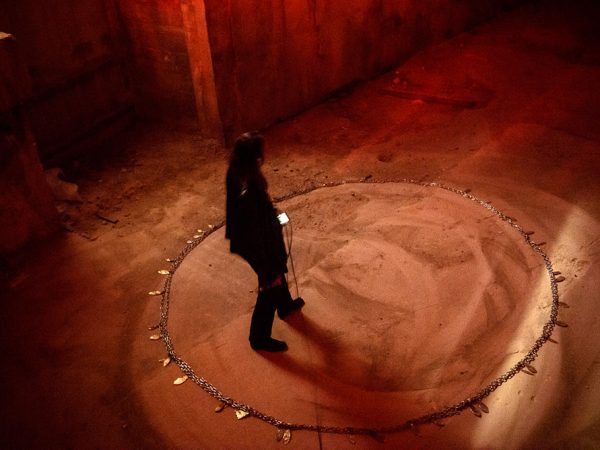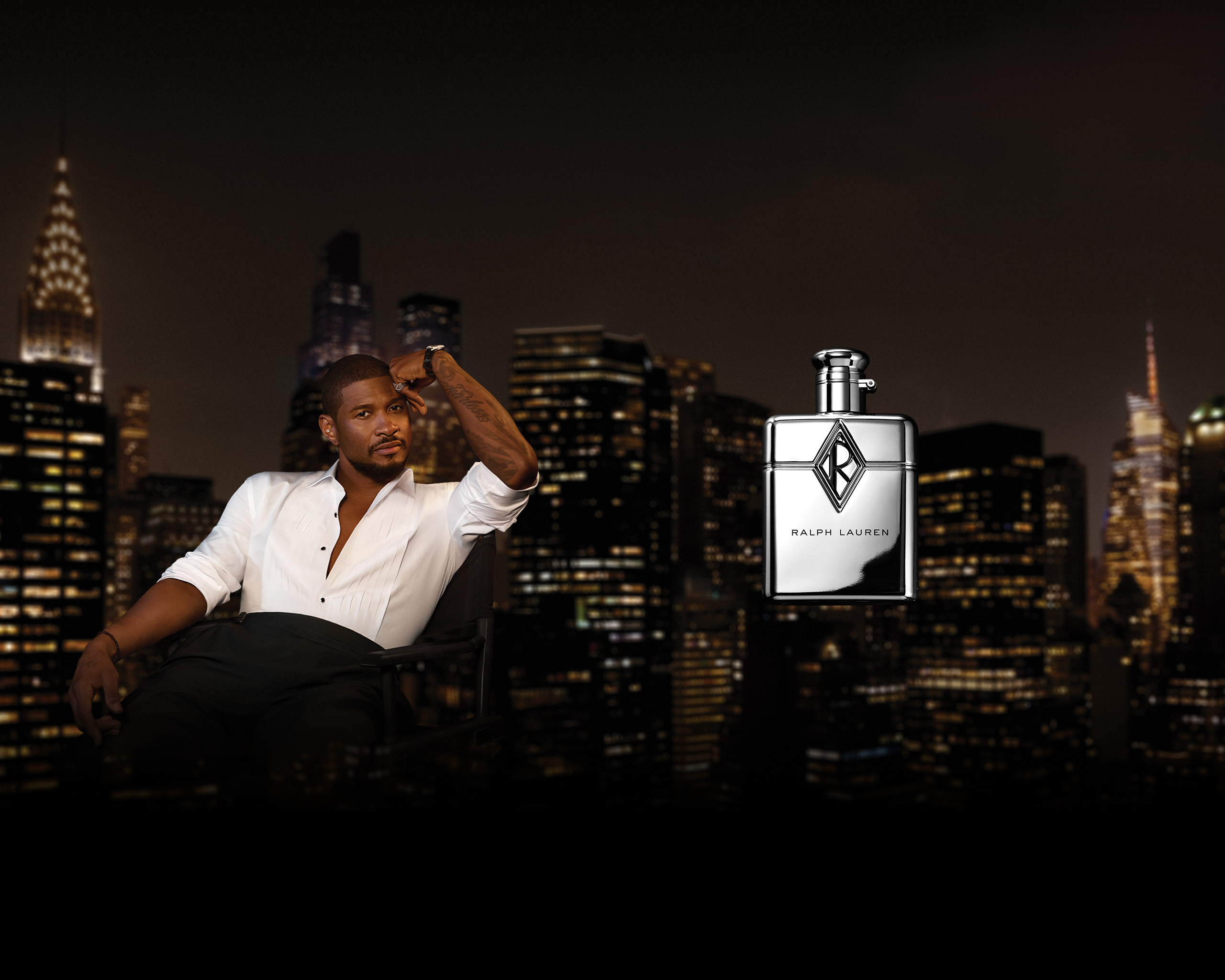As hyper-media and violence create a dysphoric present, one writer stops to survey our collective unmooring.
Some months ago, I found myself in a cave, deep beneath the American heartland. I was doing a different kind of assignment than my usual fare—an entertainment feature. A reality TV show, you see, was being filmed below ground, in utter darkness. Contestants would travel below via one cave entrance, and then try to find their way out through another, all in pitch blackness. As they proceeded—first alone, and then, if they found each other, together—they were filmed by drones, by remote cameras, and by a crew of videographers, stealthily orbiting them in the darkness. An insane venture, perhaps, but a brilliant one too—part gonzo entertainment, part endurance test, part psychology experiment, part performance art, part giant philosophical metaphor.
On the morning after filming wrapped, and the cast had departed, I got a chance to go below in the dark myself, led by a guide. We descended slowly, clambering down rock faces and squeezing through tight passages, our headlamps and flashlights throwing shadows on the jagged tunnel walls, fading into dimness over deep pits. Eventually we came to a chamber, put some space between us, turned our lights off, and sat. At first we talked: about TV, about politics, about travel, about liquor, about hunting and shooting and scuba diving, the diversions and pleasures and dramas of the world above. But eventually, after a half an hour or so—I had no way to tell time, and darkness plays tricks on you besides—a stillness overcame us. The silence was complete, the blackness, absolute. My senses, at once so hyper-attenuated and so deprived of stimulus, began to run together. The dusty smell of the cave, the metallic taste of the subterranean air, the cold of the rock beneath my gloves all merged in a synesthetic darkness. I had expected to feel some kind of atavistic terror, to fend off long-repressed demons, but nothing came, just quiet, and blackness so total I could not tell when my eyes were open or closed. Later, when we emerged from the cave, and I turned on my phone, the deluge of notifications left it vibrating for five minutes straight. There had been an incident in Washington D.C., a shooting at a pick-up baseball game. A Congressman was among the wounded.
Above The Fold

Sam Contis Studies Male Seclusion

Slava Mogutin: “I Transgress, Therefore I Am”

The Present Past: Backstage New York Fashion Week Men’s Spring/Summer 2018

Pierre Bergé Has Died At 86

Falls the Shadow: Maria Grazia Chiuri Designs for Works & Process

An Olfactory Memory Inspires Jason Wu’s First Fragrance

Brave New Wonders: A Preview of the Inaugural Edition of “Close”

Georgia Hilmer’s Fashion Month, Part One

Modelogue: Georgia Hilmer’s Fashion Month, Part Two

Surf League by Thom Browne

Nick Hornby: Grand Narratives and Little Anecdotes

The New Helmut

Designer Turned Artist Jean-Charles de Castelbajac is the Pope of Pop

Splendid Reverie: Backstage Paris Haute Couture Fall/Winter 2017

Tom Burr Cultivates Space at Marcel Breuer’s Pirelli Tire Building

Ludovic de Saint Sernin Debuts Eponymous Collection in Paris

Peaceful Sedition: Backstage Paris Fashion Week Men’s Spring/Summer 2018

Ephemeral Relief: Backstage Milan Fashion Week Men’s Spring/Summer 2018

Olivier Saillard Challenges the Concept of a Museum

“Not Yours”: A New Film by Document and Diane Russo

Introducing: Kozaburo, 2017 LVMH Prize Finalist

Introducing: Marine Serre, 2017 LVMH Prize Finalist

Conscious Skin

Escapism Revived: Backstage London Fashion Week Men’s Spring/Summer 2018

Introducing: Cecilie Bahnsen, 2017 LVMH Prize Finalist

Introducing: Ambush, 2017 LVMH Prize Finalist

New Artifacts

Introducing: Nabil Nayal, 2017 LVMH Prize Finalist

Bringing the House Down

Introducing: Molly Goddard, 2017 LVMH Prize Finalist

Introducing: Atlein, 2017 LVMH Prize Finalist

Introducing: Jahnkoy, 2017 LVMH Prize Finalist

LVMH’s Final Eight

Escaping Reality: A Tour Through the 57th Venice Biennale with Patrik Ervell

Adorned and Subverted: Backstage MB Fashion Week Tbilisi Autumn/Winter 2017

The Geometry of Sound

Klaus Biesenbach Uncovers Papo Colo’s Artistic Legacy in Puerto Rico’s Rainforest

Westward Bound: Backstage Dior Resort 2018

Artist Francesco Vezzoli Uncovers the Radical Images of Lisetta Carmi with MoMA’s Roxana Marcoci

A Weekend in Berlin

Centered Rhyme by Elaine Lustig Cohen and Hermès

How to Proceed: “fashion after Fashion”

Robin Broadbent’s Inanimate Portraits

“Speak Easy”

Revelations of Truth

Re-Realizing the American Dream

Tomihiro Kono’s Hair Sculpting Process

The Art of Craft in the 21st Century

Strength and Rebellion: Backstage Seoul Fashion Week Autumn/Winter 2017

Decorative Growth

The Faces of London

Document Turns Five

Synthesized Chaos: “Scholomance” by Nico Vascellari

A Whole New World for Janette Beckman

New Ceremony: Backstage Paris Fashion Week Autumn/Winter 2017

New Perspectives on an American Classic

Realized Attraction: Backstage Milan Fashion Week Autumn/Winter 2017

Dematerialization: “Escape Attempts” at Shulamit Nazarian

“XOXO” by Jesse Mockrin

Brilliant Light: Backstage London Fashion Week Autumn/Winter 2017

The Form Challenged: Backstage New York Fashion Week Autumn/Winter 2017

Art for Tomorrow: Istanbul’74 Crafts Postcards for Project Lift

Inspiration & Progress

Paskal’s Theory of Design

On the Road

In Taiwan, American Designer Daniel DuGoff Finds Revelation

The Kit To Fixing Fashion

The Game Has Changed: Backstage New York Fashion Week Men’s Autumn/Winter 2017

Class is in Session: Andres Serrano at The School

Forma Originale: Burberry Previews February 2017

“Theoria”

Wearing Wanderlust: Waris Ahluwalia x The Kooples

Approaching Splendor: Backstage Paris Haute Couture Spring/Summer 2017

In Florence, History Returns Onstage

An Island Aesthetic: Loewe Travels to Ibiza

Wilfried Lantoine Takes His Collection to the Dancefloor

A Return To Form: Backstage New York Fashion Week Spring/Summer 2018

20 Years of Jeremy Scott

Offline in Cuba

Distortion of the Everyday at Faustine Steinmetz

Archetypes Redefined: Backstage London Fashion Week Spring/Summer 2018

Spring/Summer 2018 Through the Lens of Designer Erdem Moralıoğlu

A Week of Icons: Backstage Milan Fashion Week Spring/Summer 2018

Toasting the New Edition of Document

Embodying Rick Owens

Prada Channels the Wonder Women Illustrators of the 1940s

Andre Walker’s Collection 30 Years in the Making

Fallen From Grace, An Exclusive Look at Item Idem’s “NUII”

Breaking the System: Backstage Paris Fashion Week Men’s Autumn/Winter 2017

A Modern Manufactory at Mykita Studio

A Wanted Gleam: Backstage Milan Fashion Week Men’s Autumn/Winter 2017

Fashion’s Next, Cottweiler and Gabriela Hearst Take International Woolmark Prize

Beauty in Disorder: Backstage London Fashion Week Men’s Autumn/Winter 2017

“Dior by Mats Gustafson”

Prada’s Power

George Michael’s Epochal Supermodel Lip Sync

The Search for the Spirit of Miss General Idea

A Trace of the Real

Wear and Sniff

Underwater, Doug Aitken Returns to the Real
We live in a moment when something is not right. This feeling is everywhere, the queasy conviction that this is not how things are supposed to be. But because the feeling is everywhere, it is also impossible to definitively localize: everything feels off. Put in other words: We have come unmoored.
Perhaps, the issue is our expectations. Things feel wrong, in other words, only because we anticipated something different. Donald Trump’s ascension to the presidency—itself a shock and surprise for so many—only typifies a broader sense of confusion. Things have not been turning out as we were led to believe. After all, at the close of the last millennium, many well-respected and well-paid intellectuals proclaimed us to be at the dawn of a new and very different era. Economist Francis Fukuyama famously termed this “the End of History”—an era beyond Cold Superpower rivalries, hoary nation-state antagonisms, or grand clashes between the totalizing ideologies of Fascism and Communism. A world made newly flat—in Thomas Friedman’s phrase—and covered in mutually interdependent markets would mean a new efflorescence of peace and stability. Now, post-9/11, post-Brexit, with self-proclaimed white nationalists marching armed in the streets and American politicians making friendly overtures to neo-fascist ultra-nationalists across the Atlantic, the breathtaking naiveté, wishful thinking, and willful shallowness underwriting these hopes feels laughable. The reports of history’s death have been greatly exaggerated.
But we do not live History. We live our lives. The pronouncements of the commentarial class about our entering a “new era” factor much less into our day-to-day awareness (if they register at all) than do our lived realities. Our expectations are less on the scope of the Global Market and World-Historical Change than they are about our checking accounts and our daily routines. In this sense, too, our expectations have been thwarted. Faith in the eternal progress of human society towards perfection is one thing. The basic expectations instilled in us by early twenty-first capitalism are another. Capital constantly tells us things are getting better, that hard work is rewarded, and that advancement is just one more hard day’s work around the corner. But the 2008 crash came and went, followed by a jobless recovery and a massive increase in a temporary, benefit-free “gig economy”; meanwhile, consumer and educational debt have mushroomed. Social mobility is at an all-time low. Insult is added to indignity. By 2018, we were told to expect flying cars and a cure for cancer. Instead, we got Long Island’s answer to George Wallace for President, apps for tracking our bowel movements, and entertainment systems that mine us for ad data while we watch TV.
Which suggests another source for the feeling of wrongness, of unmooring: the technology that surrounds us, above all, the internet and social media. We live tethered to devices that incessantly obtrude on our consciousness with notifications, alerts, updates. Hyperconnectedness generates its own kind of anomie. Liberating in principle, access to endless flows of information is overwhelming in practice. We’ve come to occupy a position of frayed receptivity—consistently brought short, waiting for the next thing, rarely recovering, always bracing. Our assertions of agency in this sphere so often boil down merely to different postures of reaction, to knee-jerk participation in circuits of amplification and repetition. Meanwhile, the meaning of the specific information at our fingertips becomes eclipsed by the experience of ceaseless exposure to data itself. Sixty years ago, Marshall McLuhan proclaimed “the medium is the message.” Today, the message is the effect—triggered outrage, shock, horror, disgust, sadness, malice, envy, escapist glee, and anxiety, all culminating in a kind of innervated numbness and despairing exhaustion.
All these factors—short-term political developments, broader historical change, the crowding buzz of networks and data—combine to leave us out of sorts. We are bewildered, thrown, dysphoric. Feeling at once incredibly up-to-the-moment and always out of sync. We float, adrift. And as we float, we sense storms building, on the horizon ahead, and in the depths below. Because the feeling of being unmoored exists directly in relation to something else, something which we go about our lives variously conscious of or sheltered from: violence.
We live in a moment when something is not right. This feeling is everywhere, the queasy conviction that this is not how things are supposed to be.
Every nation, people, and moment has its own relationship to violence. But the American relationship to violence in this age is singular and unprecedented. On the one hand, it is everywhere—exercised through a variety of institutions and practices, sustaining our very way of life. On the other, it is tightly distributed—suffered disproportionately by certain groups in certain spaces, rarely encountered by others elsewhere. What is truly remarkable is that the actual material realities of violence exist almost entirely independent of how violence is understood by the majority of Americans—particularly how its framed by the media or addressed in political rhetoric. To be sure, far too many of us know violence all too well, and experience it daily—abused by partners, brutalized by police, caged in prisons, more. But these experiences of the vulnerable and marginalized rarely filter into the American consciousness. Instead, our concept of violence is dominated by fantasy, by disattention, by disavowal.
Consider the two most obvious kinds of violence: crime and war. For nearly two decades now, a majority of Americans have consistently expressed the belief that violent crime has grown worse than the previous year—while the reality is almost the exact opposite. The number of police killed in the line of duty last year is the second-lowest in half a century. Only one in five Americans will ever report being the victim of a violent crime (sociologists have observed marked disproportionalities even within that figure as whites appear to over-report and blacks to under-report). Still yet, our political debates are dominated by talk of urban hellholes, the War on Cops, and allegations of being “soft on crime,” a dog-whistle term to support our aggressively militarized police and viciously punitive criminal justice system. The violence this apparatus inflicts is enormous: We imprison more people, both in raw numbers and per capita, than any nation on the planet, and our law enforcement is so brutal that of the one in three Americans killed by a stranger, that stranger is a cop. A preoccupation with a fantasy image of illegitimate violence—crime—coexists with a massive infrastructure of violence deemed legitimate.
As within our borders, so too does the fantasy extend beyond them. How many wars, exactly, is the United States in at the moment? It’s hard to say. Congress hasn’t made a formal Declaration of War since 1941, and the seventy-five years since have instead seen a steadily increasing pace of “humanitarian interventions,” “police actions,” and “extended military engagements.” Declarations of victory and Missions Accomplished alternate with troop build-ups and redeployments. Land is lost, then regained and lost again. One outlaw regime or cadre of terrorist villains is liquidated, only to be replaced by another. Our warmaking has taken on a surreal endlessness in both space and time. Our armed forces, far and away the largest and most powerful on earth, are active in 170-odd countries. By the year’s close, there will be Americans deployed abroad who weren’t even born when the Twin Towers fell. Not for nothing has the key military buzzword of our recent era been “surge”: an intransitive buildup of violent potential without resolution or outlet. A perfect mirror to “terror”—the amorphous abstraction that has justified an endless regime of constant, fluid fear— “surge” is also the perfect expression of the dynamics of our current unmooring: an endless ramping up, the dizzying feeling that we’ll never hit bottom, a state of restless enervation, attenuated numbness, and overtaxed hyper-vigilance.
Violence is understood as an exception to the American way of life. In fact, it is fundamentally a part of it—a condition of its very possibility.
And yet, while our war machine surges and body counts rise, we remain surreally divorced from its brutality. Violence is quarantined, suffering distributed with stark asymmetry. Only a tiny fraction of Americans ever serve in the military, and the percentile of Americans with family or acquaintances who have done so is at an all-time low. Seven thousand American soldiers killed and sixty thousand wounded since 2001 represent only a tiny fraction of our overall population. Meanwhile, U.S. operations are estimated to have killed well over one million people in Iraq, Afghanistan, and Pakistan. Breathtaking upticks in civilian casualties barely register our consciousness.
Most Americans may interact only sporadically with spectacular images of outright violence—videos of police killings and drone strikes on our devices. Framed and animated by the same glowing light through which we pay bills, do our work, and watch pornography. We are surrounded by other modes of violence, too. Being consigned to slow death from a preventable illness is a kind of violence—it kills tens of thousands of Americans each year. And so is deportation, separation from one’s family; denial of the vote and basic infrastructure, or death in immiserated poverty. To the extent to which politics is a matter of decisions yielding life or death consequences for society at large, violence is an inherent aspect. This violence is structural, and it is everywhere. Too often, though, it is abstracted, waved away, or described as the outcome of nebulous forces—“the market”—or explained by meritocratic narratives about bad choices and low character. Violence is understood simultaneously as an exception to the American way of life and as a threat to it, when, in fact, it is fundamentally part of it—a condition of its very possibility.
Violence crackles right below the surface as we drift. The maintenance of this doublethink has fallen to the respectable voices of mainstream discourse, who either maintain blissful silence in the face of brutality, wave it off as “obviously” bad (and thus beneath their attention), or intervene to chide the activist among us with very serious reflections about “threats to principle” and “slippery slopes.” Abstract platitudes about the need to respect a supposedly even-playing-field and a marketplace of ideas actively erase how violence is experienced and distributed. In a nation saturated with weapons and riven by present injustice, the media merely launder and erase the many realities of violence—structural and personal, licit and forbidden—in service of the entrenched interests of power.
The erasure and laundering of violence weaponizes powerful ideological resources. Per the pluralistic concept of the American social contract, individuals existed in a state of omnidirectional violence, all against all, until they collectively surrender up their individual recourse to violence to a powerful state. Articulated time and again by pundits, this narrative comes to serve as more than a philosophical exercise: it takes on the ring of a foundational myth, a political theology. It is like a tale of a bizarro Garden of Eden, a rise (rather than a Fall) from a violent jungle into a more peaceable kingdom. But simply reading the daily headlines—often in the same papers in which our illustrious pundits write—exposes this narrative as painfully out-of-step with reality. Liberal societies aren’t birthed magically out of a egalitarian surrendering of force. They have real-world histories, often very bloody ones, and those past traumas echo into the present.
State violence doesn’t operate on its own, impartially. It is inflicted by flawed human beings who participate in broader group antagonisms and inequalities. Even defining what constitutes “violence” itself is never politically neutral. And yet, somehow, to so many voices on American Op-Ed pages, on Twitter, or network TV, floating in a domain of abstraction, these concerns can be bracketed away into nothing. Yes, it is “unfortunate” that our police execute so many minorities with no consequence, these voices will admit, but consider, also, the threat to democracy represented by the illiberalism of Black Lives Matter protesters. Hypothetical dangers to principle outweigh the actual destruction of living bodies. For such pundits, the liberal mantras that might ideally reveal how our politics fall short, instead, become cudgels wielded against those who experience physical and material harm in an American reality they cannot escape.
From the comfortable perspective of the elite take-haver, aggressions are easily neutralized in favor of a narrative of proportional conflicts, where “both sides”are at fault, can learn from one another. By their logic, the better angels of reason and democratic procedure will prevail in the end. Yet, the Nazi, and the person he wishes to erase, are not offering competing takes. They are not two perspectives, equally deserving of recognition from the Discourse. They are political positions in material struggle, where one “side” wants simply to live, and the other’s agenda is literal murder. But our pundits all too often flatten even this most obvious asymmetry into a mere difference of opinion, something better litigated through measured arguments following appropriately polite norms. Dressed up in the language of universal, humanistic values, their counsels and warnings really just reflect their interests as privileged beneficiaries of the status quo. And even as the horror of our status quo grows ever more obvious, their counsel proceeds, apace, steadily more divorced from the realities of our moment, alternately facile, hysterical, blithe, and clueless. And all along, the storm surges.
Above the cave, still processing the news of the shooting. My voicemail box was suddenly full. Was I available for a comment, to file a piece? Covered in dust, I drove to the top of a nearby hill, trying to get better reception, to make the necessary calls. Everyone with whom I spoke was breathless, agitated, scared. What did this mean? What would happen next? Surely this latest horror would “change everything.” Early reports suggested the shooter (the only fatality) had wanted to target Republicans. Already, opportunistic commentators were demanding “denunciations” from Senator Bernie Sanders. Already, the pundits and take-havers were going about their work. “It’s easy to forget what a blessing it is to live in a country where politics rarely leads to violence, and how fragile that blessing is,” pronounced Vox’s Ezra Klein, for whom, apparently, a quadruple shooting that same weekend in Baltimore was a-political. “Part of keeping the wheels on society, of preventing anarchy, is remembering even policymakers with ideas you reject are humans with value,” chided Josh Barro of Business Insider, counseling Americans everywhere to have more empathy with “policymakers”—a wonderfully bloodless term—never mind that their “ideas” often entail many forms of violence against the vulnerable and marginalized. Ross Douthat, of The New York Times, saw in the Scalise shooting a teachable moment about how both sides are equally bad: “[This] should be an important reminder for our media-cultural establishment that societies can be pulled apart from the left as easily as from the right.” Pronouncement after pronouncement from opinion-makers asserting the proper boundaries of what should or shouldn’t count as “violence,” whose experience of violence should matter as “political” and whose shouldn’t, what we should actually fear, what we should be grateful for.
As I talked into the handset, looking out over the Mississippi River, I kept thinking of the world that lay below. The cave had been there for a hundred million years, its tunnels bored and sculpted by the rising and falling of ancient, long-gone seas. The Congressman and the others might live, or they might die. American politics as we knew it might be radically changed, or the status quo would proceed, unaltered. We could tumble into outright civil war. Or, this latest mass shooting, like the one that preceded it, and the one before that, might prove just yet another entry on some grim list. But no matter what, the cave would sit there. Its indifference to our presence, to the fact of our existence, to our agony unmoored, was total and serene.

















